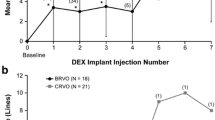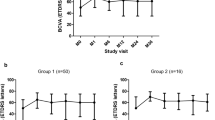Abstract
Purpose
The objective of his study was to compare the visual and anatomical outcomes in treatment-naïve patients with macular edema secondary to retinal vein occlusion after intravitreal injections of dexamethasone implants (DEX) and anti-VEGF.
Methods
One hundred two patients (64 in the anti-VEGF group, 38 in the DEX group) without previous treatment were included in this multi-center retrospective study and evaluated at baseline and 1, 3, 6, and 12 months after the onset of treatment. Patients were defined as "good responders" if central macular thickness (CMT) was less than or equal to 250 μm in TD-OCT or 300 μm in SD-OCT after the injections.
Results
At month 3 (n = 102), BCVA had increased significantly, by 0.1 ± 0.3 logMAR in the anti-VEGF group (p = 0.04) and 0.4 ± 0.4 logMAR in the DEX group (p < 0.001); the difference between the two groups was statistically significant (p = 0.007). CMT decreased significantly, by 138 ± 201 μm (−19 %, p < 0.001) in the anti-VEGF group and 163 ± 243 μm (−21 %, p < 0.001) in the DEX group. After 3 months, five patients (13 %) in the DEX group and 20 (31 %) in the anti-VEGF group (p < 0.001) changed treatment. Among the 77 patients who did not switch from their initial treatment, no significant functional or anatomical difference between the two groups was observed at months 6 and 12. Elevation of intraocular pressure > 21 mmHg was more frequent in the DEX group (21 %) than in the anti-VEGF group (3 %, p = 0.008).
Conclusions
Visual acuity recovery was better in the DEX group than in the anti-VEGF group at month 3, but with no difference in CMT. In patients who did not change treatment, the long-term anatomical and visual outcome was similar between the DEX and anti-VEGF groups.





Similar content being viewed by others
References
McIntosh RL, Rogers SL, Lim L, Cheung N, Wang JJ, Mitchell P, Kowalski JW, Nguyen HP, Wong TY (2010) Natural history of central retinal vein occlusion: an evidence-based systematic review. Ophthalmology 117:1113–1123
Coscas G, Loewenstein A, Augustin A, Bandello F, Battaglia Parodi M, Lanzetta P, Mones J, de Smet M, Soubrane G, Staurenghi G (2011) Management of retinal vein occlusion–consensus document. Ophthalmologica 226:4–28
Rogers SL, McIntosh RL, Lim L, Mitchell P, Cheung N, Kowalski JW, Nguyen HP, Wang JJ, Wong TY (2010) Natural history of branch retinal vein occlusion: an evidence-based systematic review. Ophthalmology 117:1094–1101. doi:10.1016/j.ophtha.2010.01.058
The Branch Vein Occlusion Study Group (1984) Argon laser photocoagulation for macular edema in branch vein occlusion. Am J Ophthalmol 98:271–282
Hansen LL, Danisevskis P, Arntz HR, Hovener G, Wiederholt M (1985) A randomised prospective study on treatment of central retinal vein occlusion by isovolaemic haemodilution and photocoagulation. Br J Ophthalmol 69:108–116
Campochiaro PA, Hafiz G, Channa R, Shah SM, Nguyen QD, Ying H, Do DV, Zimmer-Galler I, Solomon SD, Sung JU, Syed B (2010) Antagonism of vascular endothelial growth factor for macular edema caused by retinal vein occlusions: two-year outcomes. Ophthalmology 117:2387–2394. doi:10.1016/j.ophtha.2010.03.060
Ferrara DC, Koizumi H, Spaide RF (2007) Early bevacizumab treatment of central retinal vein occlusion. Am J Ophthalmol 144:864–871
Kreutzer TC, Alge CS, Wolf AH, Kook D, Burger J, Strauss R, Kunze C, Haritoglou C, Kampik A, Priglinger S (2008) Intravitreal bevacizumab for the treatment of macular oedema secondary to branch retinal vein occlusion. Br J Ophthalmol 92:351–355
Stahl A, Agostini H, Hansen LL, Feltgen N (2007) Bevacizumab in retinal vein occlusion-results of a prospective case series. Graefes Arch Clin Exp Ophthalmol 245:1429–1436
Campochiaro PA, Heier JS, Feiner L, Gray S, Saroj N, Rundle AC, Murahashi WY, Rubio RG (2010) Ranibizumab for macular edema following branch retinal vein occlusion: six-month primary end point results of a phase III study. Ophthalmology 117:1102–1112
Haller JA, Bandello F, Belfort R Jr, Blumenkranz MS, Gillies M, Heier J, Loewenstein A, Yoon YH, Jacques ML, Jiao J, Li XY, Whitcup SM (2010) Randomized, sham-controlled trial of dexamethasone intravitreal implant in patients with macular edema due to retinal vein occlusion. Ophthalmology 117:1134–1146
Haller JA, Bandello F, Belfort R Jr, Blumenkranz MS, Gillies M, Heier J, Loewenstein A, Yoon YH, Jiao J, Li XY, Whitcup SM, Li J (2011) Dexamethasone intravitreal implant in patients with macular edema related to branch or central retinal vein occlusion twelve-month study results. Ophthalmology 118:2453–2460
Moisseiev E, Goldstein M, Waisbourd M, Barak A, Loewenstein A (2013) Long-term evaluation of patients treated with dexamethasone intravitreal implant for macular edema due to retinal vein occlusion. Eye (Lond) 27:65–71
Channa R, Smith M, Campochiaro PA (2011) Treatment of macular edema due to retinal vein occlusions. Clin Ophthalmol 5:705–713
Campochiaro PA, Brown DM, Awh CC, Lee SY, Gray S, Saroj N, Murahashi WY, Rubio RG (2011) Sustained benefits from ranibizumab for macular edema following central retinal vein occlusion: twelve-month outcomes of a phase III study. Ophthalmology 118:2041–2049
Brown DM, Campochiaro PA, Bhisitkul RB, Ho AC, Gray S, Saroj N, Adamis AP, Rubio RG, Murahashi WY (2011) Sustained benefits from ranibizumab for macular edema following branch retinal vein occlusion: 12-month outcomes of a phase III study. Ophthalmology 118:1594–1602
Brown DM, Campochiaro PA, Singh RP, Li Z, Gray S, Saroj N, Rundle AC, Rubio RG, Murahashi WY (2010) Ranibizumab for macular edema following central retinal vein occlusion: six-month primary end point results of a phase III study. Ophthalmology 117:1124–1133
Heier JS, Campochiaro PA, Yau L, Li Z, Saroj N, Rubio RG, Lai P (2012) Ranibizumab for macular edema due to retinal vein occlusions: long-term follow-up in the HORIZON trial. Ophthalmology 119:802–809
Ding X, Li J, Hu X, Yu S, Pan J, Tang S (2011) Prospective study of intravitreal triamcinolone acetonide versus bevacizumab for macular edema secondary to central retinal vein occlusion. Retina 31:838–845
Moradian S, Faghihi H, Sadeghi B, Piri N, Ahmadieh H, Soheilian M, Dehghan MH, Azarmina M, Esfahani MR (2011) Intravitreal bevacizumab vs. sham treatment in acute branch retinal vein occlusion with macular edema: results at 3 months (Report 1). Graefes Arch Clin Exp Ophthalmol 249:193–200
Bhisitkul RB, Campochiaro PA, Shapiro H, Rubio RG (2013) Predictive value in retinal vein occlusions of early versus late or incomplete ranibizumab response defined by optical coherence tomography. Ophthalmology 120:1057–1063
The Central Vein Occlusion Study (1993) Baseline and early natural history report. Arch Ophthalmol 111:1087–1095
Conrath J, Giorgi R, Raccah D, Ridings B (2005) Foveal avascular zone in diabetic retinopathy: quantitative vs qualitative assessment. Eye (Lond) 19:322–326
Ferris FL 3rd, Kassoff A, Bresnick GH, Bailey I (1982) New visual acuity charts for clinical research. Am J Ophthalmol 94:91–96
Giani A, Cigada M, Choudhry N, Deiro AP, Oldani M, Pellegrini M, Invernizzi A, Duca P, Miller JW, Staurenghi G (2010) Reproducibility of retinal thickness measurements on normal and pathologic eyes by different optical coherence tomography instruments. Am J Ophthalmol 150:815–824
Holladay JT (1997) Proper method for calculating average visual acuity. J Refract Surg 13:388–391
Figueroa MS, Contreras I, Noval S, Arruabarrena C (2010) Results of bevacizumab as the primary treatment for retinal vein occlusions. Br J Ophthalmol 94:1052–1056
Pai SA, Shetty R, Vijayan PB, Venkatasubramaniam G, Yadav NK, Shetty BK, Babu RB, Narayana KM (2007) Clinical, anatomic, and electrophysiologic evaluation following intravitreal bevacizumab for macular edema in retinal vein occlusion. Am J Ophthalmol 143:601–606
Joshi L, Yaganti S, Gemenetzi M, Lightman S, Lindfield D, Liolios V, Menezo V, Shao E, Taylor SR (2013) Dexamethasone implants in retinal vein occlusion: 12-month clinical effectiveness using repeat injections as-needed. Br J Ophthalmol 97:1040–1044
Kriechbaum K, Michels S, Prager F, Georgopoulos M, Funk M, Geitzenauer W, Schmidt-Erfurth U (2008) Intravitreal Avastin for macular oedema secondary to retinal vein occlusion: a prospective study. Br J Ophthalmol 92:518–522
Risard SM, Pieramici DJ, Rabena MD, Basefsky JC, Avery RL, Castellarin AA, Nasir MA, See RF, Couvillion SS (2011) Intravitreal ranibizumab for macular edema secondary to central retinal vein occlusion. Retina 31:1060–1067
Yoshimura T, Sonoda KH, Sugahara M, Mochizuki Y, Enaida H, Oshima Y, Ueno A, Hata Y, Yoshida H, Ishibashi T (2009) Comprehensive analysis of inflammatory immune mediators in vitreoretinal diseases. PLoS One 4:e8158
Felinski EA, Antonetti DA (2005) Glucocorticoid regulation of endothelial cell tight junction gene expression: novel treatments for diabetic retinopathy. Curr Eye Res 30:949–957
Nauck M, Karakiulakis G, Perruchoud AP, Papakonstantinou E, Roth M (1998) Corticosteroids inhibit the expression of the vascular endothelial growth factor gene in human vascular smooth muscle cells. Eur J Pharmacol 341:309–315
Ferrara N, Damico L, Shams N, Lowman H, Kim R (2006) Development of ranibizumab, an anti-vascular endothelial growth factor antigen binding fragment, as therapy for neovascular age-related macular degeneration. Retina 26:859–870
Gado AS, Macky TA (2014) Dexamethasone intravitreous implant versus bevacizumab for central retinal vein occlusion-related macular oedema: a prospective randomized comparison. Clin Exp Ophthalmol 42:650–655
Guignier B, Subilia-Guignier A, Fournier I, Ballonzoli L, Speeg-Schatz C, Gaucher D (2013) Prospective pilot study: efficacy of intravitreal dexamethasone and bevacizumab injections in the treatment of macular oedema associated with branch retinal vein occlusion. Ophthalmologica 230:43–49
Glacet-Bernard A, Coscas G, Chabanel A, Zourdani A, Lelong F, Samama MM (1996) Prognostic factors for retinal vein occlusion: prospective study of 175 cases. Ophthalmology 103:551–560
Klein R, Moss SE, Meuer SM, Klein BE (2008) The 15-year cumulative incidence of retinal vein occlusion: the Beaver Dam Eye Study. Arch Ophthalmol 126:513–518
Manousaridis K, Talks J (2012) Macular ischaemia: a contraindication for anti-VEGF treatment in retinal vascular disease? Br J Ophthalmol 96:179–184. doi:10.1136/bjophthalmol-2011-301087
Chakravarthy U, Harding SP, Rogers CA, Downes SM, Lotery AJ, Wordsworth S, Reeves BC (2012) Ranibizumab versus bevacizumab to treat neovascular age-related macular degeneration: one-year findings from the IVAN randomized trial. Ophthalmology 119:1399–1411
Kodjikian L, Souied EH, Mimoun G, Mauget-Faysse M, Behar-Cohen F, Decullier E, Huot L, Aulagner G (2013) Ranibizumab versus bevacizumab for neovascular age-related macular degeneration: results from the GEFAL noninferiority randomized trial. Ophthalmology 120:2300–2309
Krebs I, Schmetterer L, Boltz A, Told R, Vecsei-Marlovits V, Egger S, Schonherr U, Haas A, Ansari-Shahrezaei S, Binder S (2013) A randomised double-masked trial comparing the visual outcome after treatment with ranibizumab or bevacizumab in patients with neovascular age-related macular degeneration. Br J Ophthalmol 97:266–271
Martin DF, Maguire MG, Ying GS, Grunwald JE, Fine SL, Jaffe GJ (2011) Ranibizumab and bevacizumab for neovascular age-related macular degeneration. N Engl J Med 364:1897–1908
Yasuda S, Kondo M, Kachi S, Ito Y, Terui T, Ueno S, Terasaki H (2011) Rebound of macular edema after intravitreal bevacizumab therapy in eyes with macular edema secondary to branch retinal vein occlusion. Retina 31:1075–1082
Parodi MB, Iacono P, De Benedetto U, Cascavilla M, Bandello F (2012) Rebound effect after intravitreal dexamethasone implant for the treatment of macular edema secondary to central retinal vein occlusion. J Ocul Pharmacol Ther 28:566–568
Good TJ, Kimura AE, Mandava N, Kahook MY (2011) Sustained elevation of intraocular pressure after intravitreal injections of anti-VEGF agents. Br J Ophthalmol 95:1111–1114
Mayer WJ, Remy M, Wolf A, Kook D, Kampik A, Ulbig M, Reznicek L, Haritoglou C (2012) Comparison of intravitreal bevacizumab upload followed by a dexamethasone implant versus dexamethasone implant monotherapy for retinal vein occlusion with macular edema. Ophthalmologica 228:110–116
Acknowledgments
The authors maintain full control of all primary data, and have agreed to allow Graefes Archive for Clinical and Experimental Ophthalmology to review their data upon request. The authors have no financial interests in any device or drug mentioned in this study.
Grants
Financial support was provided by the Association for Research and Education in Ophthalmology (ARFO).
Author information
Authors and Affiliations
Corresponding author
Rights and permissions
About this article
Cite this article
Chiquet, C., Dupuy, C., Bron, A.M. et al. Intravitreal dexamethasone implant versus anti-VEGF injection for treatment-naïve patients with retinal vein occlusion and macular edema: a 12-month follow-up study. Graefes Arch Clin Exp Ophthalmol 253, 2095–2102 (2015). https://doi.org/10.1007/s00417-015-2947-9
Received:
Revised:
Accepted:
Published:
Issue Date:
DOI: https://doi.org/10.1007/s00417-015-2947-9




